How can scoliosis be detected using something as simple as a bottle of water?
Scoliosis is normally correctly identified only on an X-ray.
But there also exist external signs that can suggest the presence of the spinal curves that characterize scoliosis.
One of the most important signs is a hump, in other words a difference in height between the two sides a person’s back that is easily spotted when he or she is bent forward.
A hump can be measured using a fairly simple instrument called a scoliometer.
A scoliometer is a graduated level and it is used by placing it on the back of a person in whom scoliosis is suspected.
The measurement is done by observing the movement of the small drop of mercury contained inside the graduated tube.
A scoliometer is a professional medical instrument designed to be used by specialists such as doctors and physiotherapists. In the absence of this instrument, is there a simple test for scoliosis that we can do in our own homes?
The answer is yes, and this is where the bottle of water, or TORSION BOTTLE, comes in.
Because Scoliosis can be detected using something as simple as a bottle of water?
What you need to make one
– A normal 500 ml plastic mineral water bottle, about half full of water
– A permanent marker pen
– A ruler
Ideally, it is best to use the type of bottle that has a slight narrowing of its circumference (indentation) about two thirds of the way up.
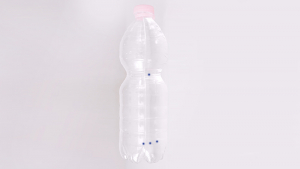
WATCH THE VIDEO
Torsion bottle
How to make one
– Place the half-empty bottle on its side on a perfectly horizontal surface.
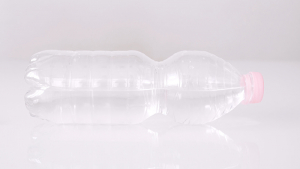
– Wait until the water is completely still. Then, at the deepest part of the indentation, mark a dot with the permanent marker pen at the level of the surface of the water (Dot 1). If the bottle has flat sides (no indentation), place the dot at around a third of the distance from the top to the bottom of the bottle.
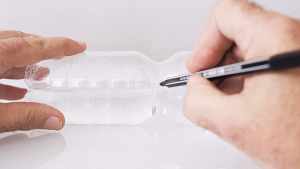
– Measure a distance of 8 cm from the dot.
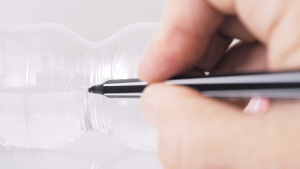
– At this distance, mark a second dot (Dot 2), again at the level of the water surface.
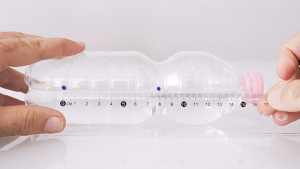
– Mark two more dots (Dots 3 and 4), one either side of the second dot. These must be placed symmetrically, each at a distance of 1 cm from Dot 2.
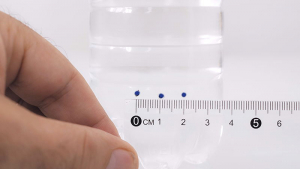
How to use it
– Have the person who is to be measured bend forward, keeping his knees straight, until his hands are about 30 cm from the ground.
This distance (30 cm) is just an indication: the person should bend forward until the part of the back that needs to be measured is in the correct position, i.e. that in which the hump is most visible in the horizontal plane relative to the examiner’s gaze
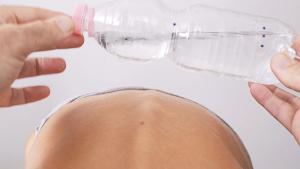
– Place the bottle crosswise on the person’s back, with the indentation positioned over the line of bony prominences at the centre of the back(Arrow A) and the water surface coinciding with dots 1 and 2.
Make sure the longer part of the bottle (in relation to the indentation) is positioned over the lower part of the back (Arrow B)
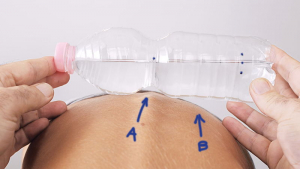
– Tilt the bottle until it touches the person’s back.
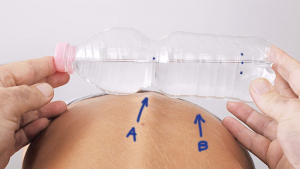
– Rotate the bottle until the surface of the water coincides with the position of Dot 1.
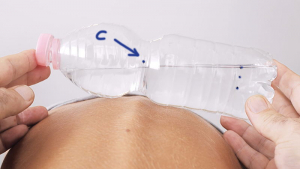
– Observe the position of the surface of the water with respect to Dot 3 or 4.
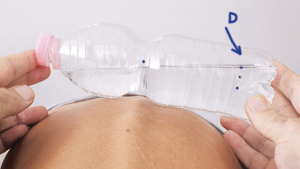
How to interpret the result
Dots 3 and 4 each correspond to about 7 degrees of inclination of the bottle. If the surface of the water lies lower than the level of the dot, this means that the hump/curvature measures less than 7 degrees. Conversely, if the surface of the water is higher than this level, the hump/curvature measurement will be greater than 7 degrees.
On the basis of the indications provided by international experts, the finding of 7 degrees of trunk rotation or more should definitely be considered an alarm signal, as it is very probably a visible external manifestation of a scoliosis that needs specific specialist assessment.
Do not forget
If the Torsion Bottle is to be used for a series of checks over time, the amount of water contained in it must remain constant. Screw the top on very tightly to prevent the water from evaporating and mark the level of the water on the bottle so that more can be added if necessary.

